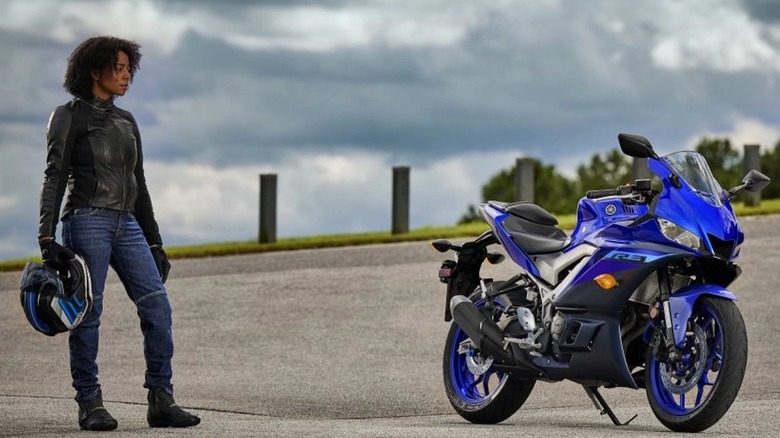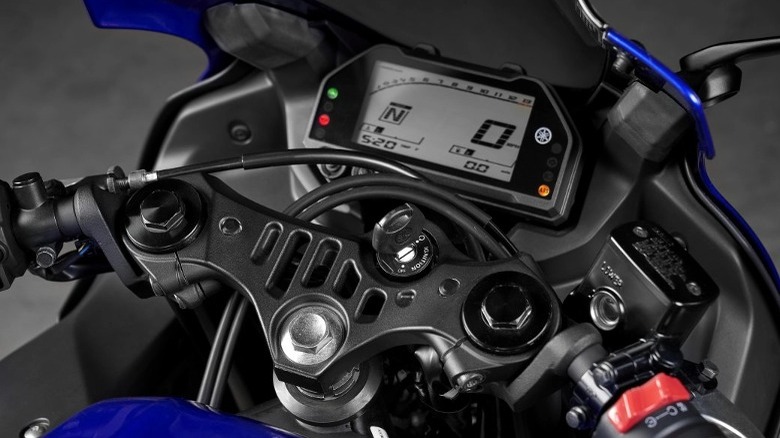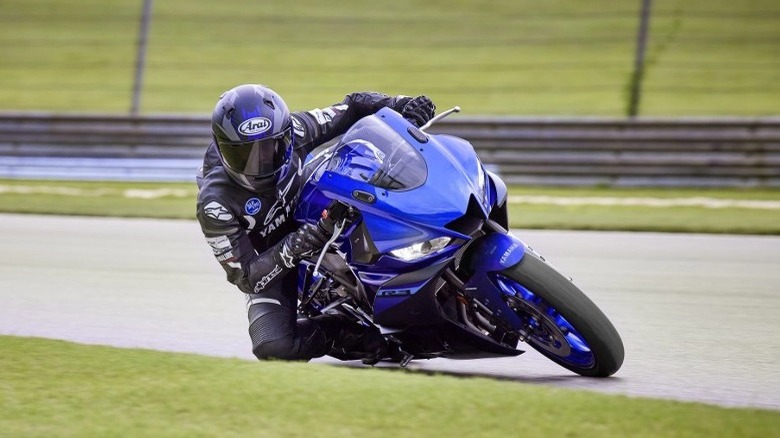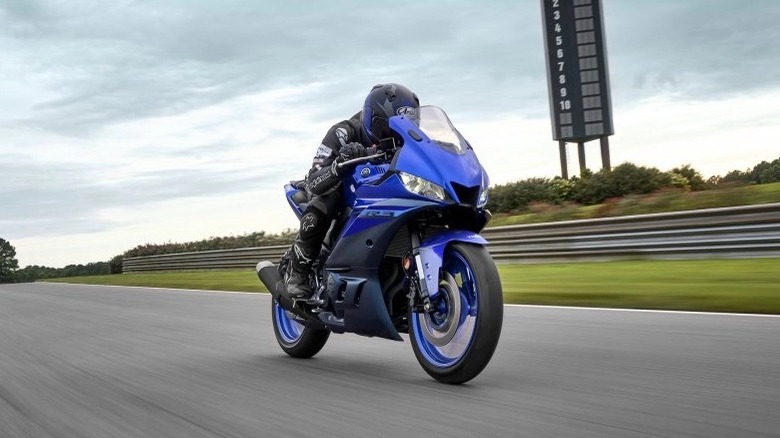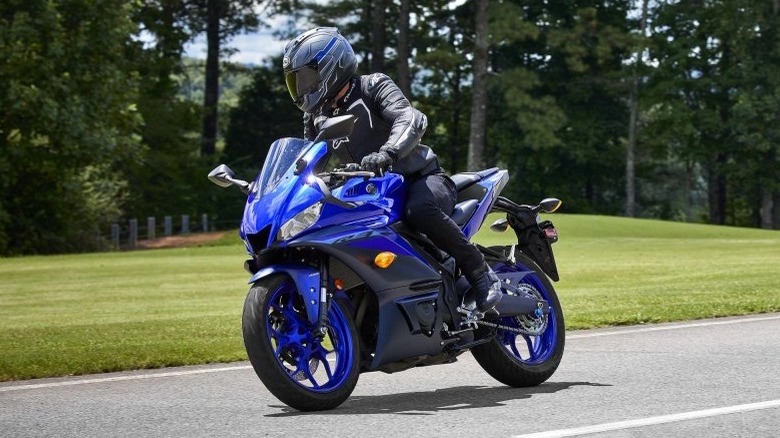Is The Yamaha R3 A Good Touring Motorcycle? Here's What Riders Say
There are a lot of different kinds of motorcycles, and each of them specialize in different kinds of riding. For instance, street bikes excel at short-distance urban riding, while adventure motorcycles are designed to be just as good at conquering dirt trails as they are when riding on the pavement. That doesn't mean you can't do other types of riding, however.
The Yamaha YZF-R3 is a sports bike, which typically means the manufacturer prioritized performance over comfort in its design. A sports bike is better suited to short bursts of speed at the racetrack than it is at eating up long miles on cross-country trips. The R3 is the smallest engine motorcycle in Yamaha's R series, but there are a lot of riders out there who may have purchased an R3 as their daily ride and are curious how suited it might be for a longer road trip.
Bikes that are made for touring usually have a few specialized design features that make the miles go a little bit more comfortably. They're larger, have high RPM and torque thresholds, lots of storage space, larger gas tanks, and place the rider in a more upright and ergonomic posture to alleviate pressure from the lower back. To understand if the YZF-R3 is a good touring motorcycle, you should first consider if its specs offer any of these features, and then take a look at what both professional reviewers and people who've tried to take the bike on longer rides have to say.
The YZF-R3 has plenty of grunt, but expect to gas up often
To understand whether or not the YZF-R3 is a good touring motorcycle, it pays to first consider its specs and features. The R3 is considered to be easy to handle even if it isn't quite as powerful as something like the Ninja 400. This bike runs on a 321cc liquid-cooled, 4-stroke, DOHC inline twin-cylinder engine with 4 valves per cylinder. This has a 68.0mm bore, a 44.1mm stroke, and a compression ratio of 11.2:1. That's adequate for highway travel, but it's not exactly a beast, so heavier riders may need to be a little generous with the throttle when getting up to speed.
This can be tiresome for the rider and hard on the bike over longer trips with a lot of traffic, and it will become more acute if you're bringing an abundance of luggage or gear on your trip, so it's definitely something to be aware of. It does have a six-speed transmission with plenty of headroom, though, so once you get up to speed on the highway or freeway, you should be able to easily shift into a comfortable gear that's well below the redline for easier cruising.
It has a 3.7-gallon tank and an average fuel economy of 56 mpg. That means that you will have to refuel your bike about once every 200 miles. That's actually not bad for a sports bike, but it's definitely on the lower end for a touring motorcycle. You'll need to refuel every few hours, and you'll also need to be aware of any long stretches between gas stations ahead of time.
Expect soreness after riding the YZF-R3 long enough
Now let's take a look at the YZF-R3's overall design. At a glance, its structure appears to deviate very little from your typical sports bike — though it's often counted as one of the coolest looking 300cc motorcycles ever made. This, unfortunately, means that it places the rider in a strongly forward-leaning posture. Sports bikes do this to decrease wind resistance for the sake of speed, and to lower the center of gravity of the rider so they can lean more sharply through tight turns. This makes them great for cornering on the kind of roads that you might find during rides in coastal and canyon regions, but it can get very uncomfortable on longer trips.
I personally ride a Honda CBR600RR, which is structurally similar to the R3, and even relatively brief two-hour trips to the coast and back can sometimes leave me with an aching lower back if I don't take breaks to stretch along the way. That said, the R3 doesn't place the rider in quite so aggressive a seating position, so you can likely make it a bit farther before the aches and pains set in. This is its biggest advantage over otherwise similar sports bikes when it comes to touring.
The R3 also doesn't come with an abundance of storage options. This isn't actually that big a deal if you have a bit of money to spend on some aftermarket additions, though. You can easily add a small tail bag, some moderate-sized saddle bags, and even a tank bag if you want to expand your options. Just be aware that too much-added weight will affect both your expected mileage and performance.
What do reviewers think of the YZF-R3?
It's always worth taking a look at what professional reviewers have to say in order to get a feel for real world applications. Arden Kysely of Rider took his YZF-R3 on a touring trip up Route 1 on the west coast. He outfitted the bike with bags and cranked up the rear shock's preload to help account for the extra weight. "The R3 cruises at typical over-the-limit California freeway speeds without breathing hard, its counterbalancer keeping things relaxed at the seat, bars and pegs" he stated. "Though some vibration creeps in at various rpm, I never found it annoying."
Kysely pointed out that he enjoyed pushing the RPMs while accelerating and that it was part of the fun of riding a motorcycle like this. He also reported that, "The seating position is sporty but mild, with top-mounted clip-on handlebars, moderately rearset pegs and a comfortable, 30.7-inch-high seat that tapers for easy ground control. My 68-inch frame was right at home and my rear wasn't complaining."
Kyseley took his trip on a 2016 model, however, and several changes were instituted in 2019. "Shortcomings in suspension and handling were addressed during the update in 2019 when engineers added a new KYB fork and triple clamp and stiffened the rear suspension settings," says Motorcyclist. "Handlebar position was changed and the fuel tank was lowered as well. They also upgraded to Dunlop GPR-300 tires."
These improvements to suspension and riding ergonomics mean that those with R3's made after 2019 should expect even better touring performance than those on older models.
What do riders think of the YZF-R3?
Finally, it's time to take a look at what people who actually use the R3 as their daily ride have to say about its touring capabilities. Reddit user Capriscious92 started a thread asking riders what the longest ride they had ever taken on their R3 was, and how it performed. The top-voted answer came from a user going by the name Starpiercer, who claimed that they had made multiple trips covering the over 600-mile distance from Fresno, CA, to Flagstaff, AZ. They stated that the biggest issue was seat comfort, but the bike performed well.
Other users confirmed the seat issue, likewise stating that the bike could easily make longer trips with few other issues. So, you may wish to invest in an aftermarket seat if you're planning on riding for longer stretches. Another contributor who went by a_nayar said that there might be other comfort issues as well. They stated that the knees, groin, and back will grow uncomfortable on a long enough ride, but "With stops planned every 50 or so miles it should be totally doable."
A post from Privilege15 on R3 Forums listed the top speeds in each gear, stating that 4th gear topped out at 78.2 mph, 5th gear topped out at 92.4 mph, and 6th gear topped out at 106.2 mph. This suggests that even with the added luggage weight, most riders should be able to easily cruise at highway speeds without leaning on the throttle too much.
